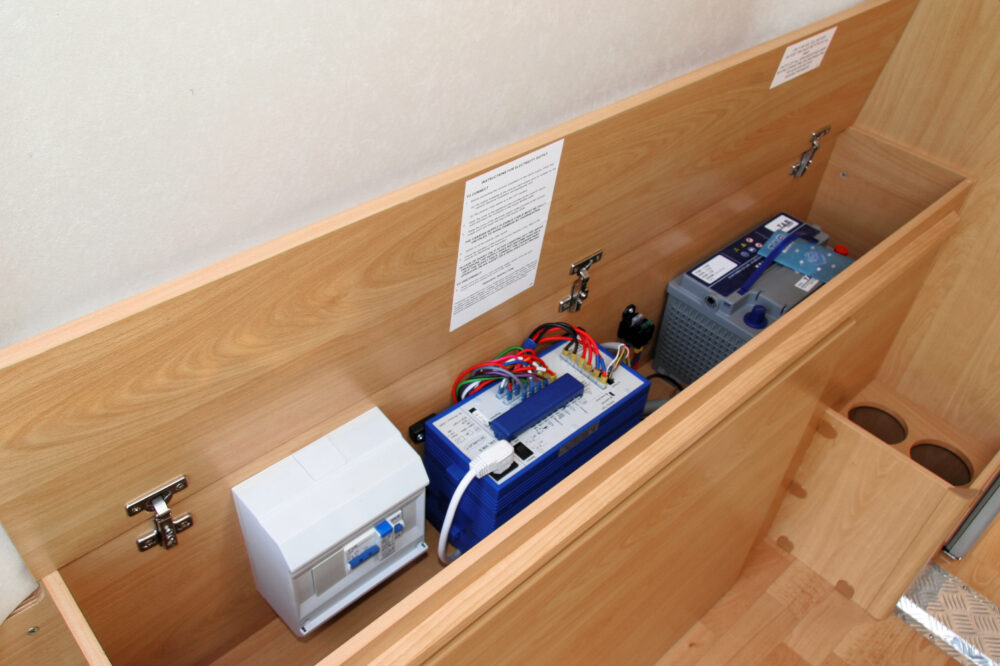AGM Batteries vs Flooded Batteries: What’s The Difference?
When you’re choosing a battery for your RV, there are several options you’ll need to consider. Most RVs will come with a battery pre-installed, so you can choose to keep the existing model or switch it out for something that will better suit your needs. There are lots of options for RVers, but many people have a hard time choosing between AGM batteries and flooded batteries.
AGM (absorbed glass mat) batteries do not include liquid, unlike flooded batteries. Both options have pros and cons, but they can be used within an RV to charge appliances, run lighting, and power everything else you might need. At the end of the day, the choice is up to you, but there are some unique features to each battery that may help you make an informed decision.
Below we have a comparison between AGM and flooded batteries so you can determine which one will be the best fit for your RV. As long as you have some type of battery you’ll be okay, but choosing the right model will improve your travel experience. Let’s get into it!
AGM batteries: Pros and cons
As mentioned above, AGM stands for absorbed glass mat. These are lead-acid batteries where the acid is absorbed into glass mats. These mats are then interspersed with lead plates.
Pros
One of the biggest benefits of AGM batteries is that they recharge much faster than their flooded counterparts. Some models can even charge up to five times faster, which is a huge difference! If you need to power up your battery as soon as possible, an AGM model would be perfect for you.
Another benefit to these batteries is that they don’t contain any loose liquid. The acid is absorbed into the glass, so it doesn’t spill or slosh around when the battery is jostled. As a result, you can store these batteries in any position (other than upside down) without worrying about leaks. Everything is sealed and self-contained, so you don’t need to top it off or worry about evaporation.
You also don’t need to worry much about cold-weather storage for these models because the liquid inside is resistant to temperature drops. They can still become corroded over time, but this process happens much more slowly compared to flooded models. It’s easy to clean them and keep them running for long stretches of time. Some models can last for seven years or more!
In addition, AGM batteries have some of the highest battery voltage outputs in the world. You can get the most bang for your buck here without worrying about power loss or energy leaks. In fact, you can use up to 80% of the charge before it takes any damage.
Cons
On the downside, AGM batteries are heavier than some other battery alternatives (such as lithium options). Each one weighs around 70 lbs, so if you have multiple batteries, this will add a significant amount of weight to your vehicle.
They are also one of the most expensive options on the market. These are military-grade batteries, and that kind of performance comes with a high price tag; the average AGM battery costs between $200-$300. If you damage it and need to replace it, it’ll cost you a pretty penny.
These are also prone to damage if they are overcharged. If you fill these batteries up past their capacity, they can overheat. This practice will eventually shorten their lifespan, so you could easily ruin an AGM battery if you charge it too much. To prevent this, you should always use a regulated battery charger.

Flooded batteries: Pros and cons
A flooded lead-acid battery has most of the same components as an AGM, but they’re in a different arrangement and form. As the name suggests, there is a liquid component to this type of battery. They contain a series of lead plates, which are then submerged in sulfuric acid. In order to keep the levels stable, users must add distilled water to the battery once the liquid starts to evaporate.
Pros
Most RVs are equipped with flooded batteries. This is the most common type, and it’s easy to find replacements if you need a new one. There’s no shortage of flooded models on the market, and this is the format that most drivers and mechanics are probably used to dealing with.
These batteries are around the same price as AGM batteries, and they can last for quite awhile if they are properly cared for. The average lifespan is between three to five years. So, if you want something that’s functional and long-lasting, this is a decent option.
Overcharging is an issue for any type of battery, but flooded batteries are more resistant to overcharging damage. If you accidentally overcharge the battery, it may be a bit less efficient, but it should still work just fine. However, you should still use a regulated battery charger just in case.
Cons
Once again, flooded batteries are heavier than some other RV alternatives. Each one is around 70 lbs when they’re fully topped off. However, this means that they’re about the same weight as AGM models, so this factor doesn’t matter as much to the pros/cons comparison. Just remember that there are lighter batteries on the market if this is a problem for your RV.
Maintenance is one of the biggest drawbacks of a flooded battery. As mentioned above, these need to be topped off with distilled water if you want them to continue to function. The liquid inside can also freeze or leak out if you store them improperly. They need to be kept upright at all times, which limits the number of possible configurations for installation.
Flooded batteries are also prone to corrosion over time. They produce gas and steam, plus the liquid can sometimes bubble out and stain the surface. Sulfation will begin to corrode the battery if it has been discharged for a long time. This can be cleaned away, but that’s just another aspect of maintenance for these items.
These batteries also take longer to charge up. It takes about eight hours to reach a healthy charging level, which is much slower than the time needed to charge an AGM. In addition, these batteries can become damaged if you use more than 50% of their discharge. That leaves a huge portion of energy that you can’t touch without consequences.
Once you go beyond this level, you’ll shorten the lifespan of the battery (which is already shorter than an AGM). If you’re not careful about maintenance and proper charging, you can run flooded batteries into the ground quite rapidly.
Consider lithium batteries
AGM batteries are superior to flooded models in almost every way. They have a better discharge output, require less maintenance, charge up significantly faster, and are designed to be strong and durable. The main downside here is the price and the risk of overcharging them.
So, if you want to invest in a good long-term battery for your RV, you’ll probably be better off with an AGM. Flooded batteries aren’t necessarily bad, but their performance just doesn’t measure up to the competition.
If you want to get a battery that’s lighter and is ideal for boondocking, you also should look into lithium-ion batteries. Learn more about lithium ion batteries from RV LIFE.
Forums such as iRV2.com and blog sites like RV LIFE, Do It Yourself RV, and Camper Report provide all the information you need to enjoy your RV. You’ll also find brand-specific information on additional forums like Air Forums, Forest River Forums, and Jayco Owners Forum.
Related articles:




In all my research including calling manufacturers with questions I find lithium batteries are a joke in an older class c for example one lithium battery is upwards of $800 to $1000 each and not one lithium battery will actually start an on board generator and I would have to purchase a dc to dc charger and a bigger alternator which adds a bigger cost. I found Optima Batteries the best option for my rig they are AGM batteries and can handle a a small solar panel system which we have. Lithium batteries are great for those that have 100% solar system. To convert my rig to 100% solar it was quoted around $20k by two different vendors at the RV show in Tampa.
No one ever talks about engine start batteries. It’s always about house batteries. What about using AGM or Lithium for engine start?
with prices of 100ah lithium as low as $300 almost as low as AGM and ability to use 80% or more vs 50% of fla or agm only charging lower than 32 F 0-C
IS only down side . another to charge from alternator you need dc to dc charger
solar no problem
The AGM is a very good battery but the other con is if you let one die. You cannot just put a charger on it to bring it back to life. There is a special procedure to recharge it by connecting a wet cell battery in parallel to the AGM and connecting the charger at a low amp setting to the flooded battery. It will take a while but once you get the voltage up to about 4 volts in the AGM you can take the flooded battery out of the circuit and connect directly to the AGM still at a low amp setting. Make sure that you charger is rated for an AGM battery. Happy camping.